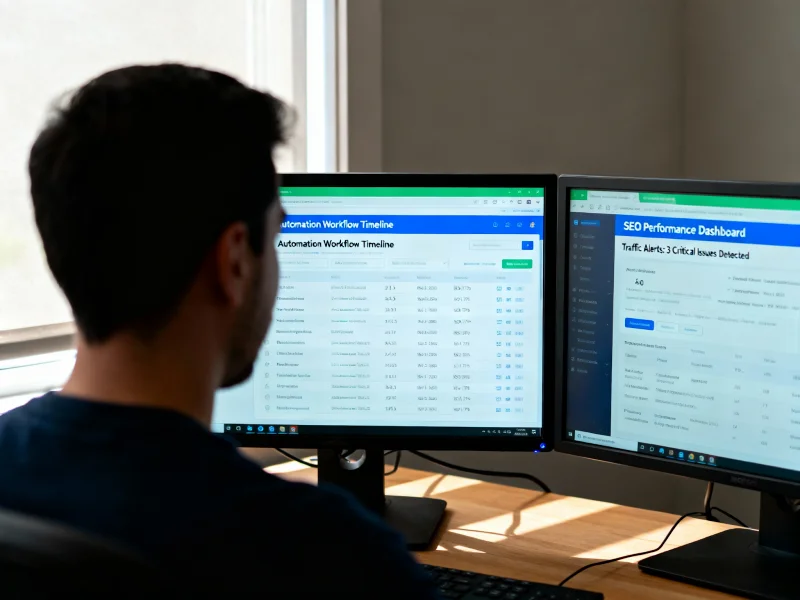What Is Local SEO? Definition, Key Features, and How It Differs From Traditional SEO
Local SEO is a strategic approach that enhances a business’s online presence to improve visibility within specific geographic locations.
This method focuses on key elements such as optimizing Google My Business listings, utilizing local keywords, and encouraging customer reviews to boost visibility.
Unlike traditional SEO, which aims for a broader audience, local SEO centers on proximity and relevance to effectively reach local customers.
This targeted strategy enhances engagement and reinforces connections within the community.
By exploring effective strategies and key performance indicators, businesses can achieve successful implementation of local SEO practices.
Key Takeaways
- Local SEO enhances a business’s online visibility within specific geographic areas, attracting local customers.
- Key features of local SEO include optimizing Google My Business profiles, targeting local keywords, and maintaining consistent NAP (name, address, phone number) across online listings.
- Customer reviews influence local rankings, shape online reputation, and enhance credibility among potential customers.
- Unlike traditional SEO, local SEO prioritizes proximity and relevance, using geographic modifiers in keywords to connect with local audiences.
- Local SEO strategies focus on local citations and community engagement rather than solely relying on high-authority backlinks to improve visibility in specific regions.
Understanding Local SEO
Local SEO is the process of optimizing a business’s online presence to improve visibility in local search results. This strategy is crucial for businesses seeking to attract customers in their vicinity, as it significantly influences their discoverability in a digital marketplace that is increasingly competitive. Understanding the importance of local SEO is vital for any business aiming to succeed and grow in today’s environment. By prioritizing local search optimization, businesses can effectively connect with potential customers in their area, enhancing their chances of success.
What Is Local SEO? A Simple Definition
Local SEO refers to search engine optimization that is tailored to specific geographic areas. This strategy is designed to enhance a business’s online visibility and attract local customers, making it crucial for companies that focus on serving particular communities or regions. Understanding local SEO involves implementing various strategies, such as optimizing Google My Business listings, effectively managing customer reviews, and using localized keywords.
The essence of local SEO revolves around its relevance to local search queries. Key factors that influence how local SEO operates include location-based ranking signals and user engagement metrics, which contribute to a business’s appearance in local search results.
How Local SEO Helps Businesses Gain Visibility
When businesses optimize their online presence for specific geographic regions, they enhance their visibility among local consumers. Implementing local SEO strategies allows small businesses to target consumers searching for products or services in their vicinity. A critical component of local SEO is ensuring NAP consistency, which stands for Name, Address, and Phone number. Maintaining uniformity in these details across all online platforms builds trust and can lead to improved search engine rankings.
Businesses can also improve their local search rankings by utilizing local keywords, creating comprehensive Google My Business profiles, and encouraging customer reviews. By focusing on these strategies, businesses can effectively attract local clientele and distinguish themselves in competitive markets.
Why Local SEO Matters in Today’s Digital Landscape
In today’s digital environment, the significance of local SEO is undeniable, as it directly influences how businesses engage with their target audience. Key local SEO factors, such as optimizing Google My Business and managing online reviews, are essential for enhancing visibility in local search results. A comprehensive guide to local search engine optimization provides actionable strategies that help businesses effectively attract nearby customers. By adhering to best practices in local SEO, companies can strengthen their online presence, boost foot traffic, and increase conversion rates. As consumers increasingly depend on local searches for their purchasing decisions, prioritizing local SEO is crucial for businesses seeking to succeed in a competitive online landscape.
Key Features of Local SEO
Understanding the key features of Local SEO is crucial for businesses looking to improve their online visibility in specific geographic areas. This involves optimizing Google Business Profiles, targeting relevant local keywords, and maintaining consistent NAP (Name, Address, Phone number) information. Effective management of local citations and customer reviews is also vital in establishing a strong online reputation. By focusing on these elements, businesses can enhance their presence in local search results and better connect with their target audience.
Google Business Profile Optimization
Optimizing your Google Business Profile is vital for increasing your local business’s visibility in search results. By utilizing effective Google Business Profile SEO strategies, businesses can ensure that essential information—such as hours of operation, location, and services offered—remains accurate and up-to-date. This optimization is an integral part of local SEO, which focuses on attracting customers based on their geographical location, distinguishing it from traditional SEO that often prioritizes broader website rankings.
Understanding the difference between local SEO and traditional SEO highlights the importance of optimizing your Google Business Profile to draw in nearby customers. Engaging visuals and authentic customer reviews can significantly enhance your profile, leading to improved local search rankings. Ultimately, a well-optimized Google Business Profile is essential for businesses looking to succeed in competitive local markets.
Local Keyword Targeting and Search Intent
How can local keyword targeting shape a business’s online presence? By effectively utilizing a local keyword research guide, businesses can identify the terms potential customers use when searching for local products or services. This method emphasizes the distinction between local and organic SEO, focusing on geographic relevance. Understanding search intent is essential; it enables businesses to tailor their content to meet the specific needs of local consumers. Local SEO link building tactics, such as acquiring backlinks from regional websites, can enhance a site’s authority and visibility in local search results. A strategic emphasis on local keywords not only improves rankings but also drives targeted traffic, helping to build stronger connections with local audiences.
NAP Consistency (Name, Address, Phone Number)
Maintaining NAP consistency—referring to the Name, Address, and Phone Number of your business—is crucial for local SEO. Ensuring uniformity across various online platforms, including your website, social media profiles, and online directories, builds your business’s credibility and trustworthiness. When NAP information is inconsistent, it can create confusion for both search engines and potential customers, which may negatively impact your visibility in local search results. Search engines prioritize accurate and reliable information, and any discrepancies can hinder your ability to achieve a strong ranking.
To enhance your chances of being discovered by local consumers, it is important to regularly audit your NAP details. Verify that they are accurate and consistent across all platforms. By taking these steps, you can increase foot traffic to your business and drive sales effectively.
Local Citations and Directory Listings
Local citations and directory listings are essential for improving a business’s visibility in local search results. These citations involve mentions of a business’s name, address, and phone number (NAP) across various online platforms, including local directories and review sites. Maintaining accurate and consistent citations is crucial, as it helps search engines validate a business’s information, thereby enhancing its credibility and ranking in local searches.
Directory listings also typically include important details such as operating hours, services offered, and customer reviews. This information can significantly influence potential customers’ decisions. By ensuring their business is listed in reputable directories and that all information is consistent, companies can effectively enhance their local SEO efforts and attract a larger local clientele.
Customer Reviews and Online Reputation Management
Customer reviews are essential in shaping a business’s online reputation and can significantly influence its local SEO performance. Positive reviews enhance credibility and draw in potential customers, while negative feedback can discourage them. Search engines assess both the quantity and quality of reviews when determining local rankings, making it crucial for businesses to manage their online reputation effectively. Encouraging satisfied customers to share their experiences can strengthen a company’s position in local search results. Responding to reviews—whether they are positive or negative—reflects a commitment to customer service, which builds trust and engagement. By prioritizing customer feedback and reputation management, businesses can enhance their visibility in local search results and ultimately drive increased traffic to their locations.
Localized Content and Geo-Targeted Landing Pages
Effective online reputation management is essential for businesses aiming to enhance visibility through localized content and geo-targeted landing pages. Localized content involves creating tailored information that resonates with a specific geographic audience, such as local events, news, or cultural highlights. This strategy enables businesses to connect with potential customers on a personal level, building trust and engagement.
Geo-targeted landing pages are specifically designed to serve users in particular locations. These pages typically incorporate localized keywords and relevant calls to action, ensuring that the content aligns with the needs of the local audience. By optimizing these pages for local search queries, businesses can improve their chances of appearing in search results for users nearby. This focused approach not only enhances search engine rankings but also increases conversion rates by addressing the specific needs of local customers directly.
Mobile Optimization for Local Searches
A well-optimized mobile experience is crucial for businesses aiming to attract local search traffic. As more people rely on smartphones to find services, having a mobile-friendly website is essential. This involves a responsive design that adjusts smoothly to different screen sizes, ensuring easy access and quick loading times. Local businesses should also integrate features like click-to-call buttons and interactive maps, which enhance user engagement. Optimizing for voice search is important, as many users use voice commands to locate nearby services. By prioritizing mobile optimization, businesses can enhance their visibility in local search results, draw in more customers, and ultimately increase foot traffic to their physical locations.
Local Link Building and Community Engagement
Many businesses prioritize website optimization, but local link building and community engagement are vital for enhancing local SEO. Local link building involves acquiring backlinks from relevant, local websites, allowing search engines to better recognize a business’s connection to the community. This can be achieved through partnerships with local organizations, sponsorships, or collaborations with other local businesses.
Community engagement cultivates relationships with local customers and boosts brand visibility. Participating in local events, interacting on social media, and providing valuable content tailored to regional interests are effective ways to engage. When combined, these strategies improve search rankings and establish trust and loyalty within the community, ultimately driving increased foot traffic and online inquiries.
How Local SEO Differs From Traditional SEO
Local SEO is designed to attract customers within a specific geographical area, setting it apart from traditional SEO, which targets a wider, global audience. The key differences lie in the ranking factors that emphasize proximity and relevance to local searches, leading to distinct search results such as the Local Pack in contrast to organic listings. Strategies for keyword selection and content creation are tailored to specific locations, focusing on the unique needs and interests of local users rather than general topics. This approach ensures that businesses can connect effectively with their target audience in their respective communities, emphasizing the importance of understanding competitor strategies in local markets to enhance visibility and engagement.
Target Audience: Local Customers vs. Global Reach
Understanding the distinctions between target audiences is essential for businesses looking to enhance their online presence. Local SEO focuses on customers within a specific geographical area, making it vital for businesses that depend on foot traffic or local clientele. This approach allows businesses to customize their marketing strategies to align with the needs and preferences of the surrounding community.
In contrast, traditional SEO aims for a global reach, attracting a wider audience without geographic constraints. Businesses that leverage local SEO often prioritize localized content, such as city-specific keywords and community engagement, while traditional SEO strategies may involve broader content that appeals to a general audience.
Recognizing these differences helps businesses effectively tailor their marketing strategies to connect with the right audience, whether that be local customers or a global market. By understanding the unique characteristics of each approach, businesses can optimize their online efforts to better serve their customers.
Ranking Factors: Proximity, Relevance, and Prominence
The differences in target audiences between local and traditional SEO also extend to the ranking factors that affect visibility in search results. In local SEO, proximity is crucial; search engines prioritize businesses that are located closer to the user. Relevance is equally important, as search engines evaluate how well a business aligns with the user’s query by considering elements such as keywords and the services offered. Prominence pertains to the overall reputation of a business, which can be assessed through online reviews, backlinks, and social media presence. These factors work together to help search engines provide results that are not only nearby but also tailored to the user’s specific needs, significantly enhancing the local search experience compared to traditional SEO methods.
Search Results: Local Pack vs. Organic Listings
Traditional SEO primarily focuses on organic listings that appear based on their relevance and authority. Local SEO, however, introduces a unique element known as the Local Pack. This feature highlights a selection of businesses that align with a user’s search intent, prominently positioned at the top of search results. The Local Pack usually includes a map and three local business listings, underscoring their proximity to the searcher’s location. In contrast, organic listings are ranked according to a website’s overall authority and content quality, often appearing lower on the search results page. The presence of the Local Pack influences user behavior, as many users tend to click on these highlighted local options instead of scrolling through the organic results.
Keyword Strategies: Geographic Modifiers vs. Broad Keywords
In local SEO, keyword strategies often focus on the use of geographic modifiers, distinguishing them from broader keywords typically found in traditional SEO. Geographic modifiers, such as city names or neighborhoods, enable businesses to target their audience more effectively. By integrating these location-specific terms, local businesses can improve their visibility in search results pertinent to their area, thereby attracting customers who are actively searching for services nearby.
In contrast, traditional SEO emphasizes broader keywords that may not include a geographic component, aiming for a wider audience but lacking the specificity that local engagement requires. Understanding this distinction is crucial, as it empowers local businesses to connect directly with potential customers in their immediate surroundings. This approach not only enhances visibility but also ensures that the content resonates with those looking for localized services.
Content Strategy: Location-Specific Pages vs. General Content
To effectively engage local customers, businesses should consider a content strategy that emphasizes location-specific pages. By crafting content tailored to the interests and needs of the local audience, businesses can create a more meaningful connection with their community. These pages typically incorporate local keywords, detailed neighborhood descriptions, and information about relevant events, making them particularly attractive to nearby customers.
While general content may reach a broader audience, it often lacks the personal touch that local consumers desire. Although this type of content can enhance brand visibility, it is the location-specific pages that truly drive engagement and conversions within local markets. By concentrating on localized content, businesses can strengthen their ties with the community, leading to improved local SEO performance and increased customer loyalty.
This strategic focus on location-specific content is essential for effective local marketing, helping businesses to better serve their customers and fulfill their needs.
Link Building Approach: Local Citations vs. High-Authority Backlinks
Local SEO differs from traditional SEO primarily in its approach to link building strategies, especially regarding the importance of local citations versus high-authority backlinks. Local citations are mentions of a business’s name, address, and phone number found across various online directories and platforms. These citations improve visibility within a specific geographic area and contribute to establishing credibility. In traditional SEO, the focus is often on acquiring high-authority backlinks from reputable websites, which can enhance overall site authority. However, these backlinks may not significantly influence local search rankings. Therefore, local SEO prioritizes building connections within the community, ensuring that businesses receive the recognition and ranking they deserve in local search results through strategic local citations.
Importance of Google Business Profile in Local SEO
Many businesses understand the significance of establishing an online presence, but the Google Business Profile (GBP) is particularly vital for local SEO strategies. This complimentary tool enables businesses to manage their online information across Google, ensuring that essential details such as location, hours, and services are accurately displayed in search results. An optimized GBP can significantly improve visibility in local searches, attracting customers in the vicinity.
User-generated content, including reviews and photos, plays a crucial role in building consumer trust and engagement. By utilizing GBP features such as posts and Q&A, businesses can engage directly with potential customers. An effective Google Business Profile is key to enhancing local search rankings and driving foot traffic to physical locations.
How to Implement an Effective Local SEO Strategy
An effective local SEO strategy requires a diverse approach. Key components include optimizing your Google Business Profile, conducting thorough local keyword research, and creating content that resonates with local audiences. Building a strong backlink profile through local partnerships and actively managing customer reviews can significantly improve your visibility and engagement. By focusing on these elements, you can enhance your online presence and connect meaningfully with your community.
Setting Up and Optimizing Your Google Business Profile
To enhance local search visibility effectively, businesses should focus on setting up and optimizing their Google Business Profile. This profile is a vital resource for attracting local customers, as it provides essential information such as the business address, phone number, and hours of operation. It is crucial for businesses to ensure that their information is accurate, complete, and consistent with other online listings. Incorporating high-quality images can significantly boost customer engagement. Actively engaging with customer reviews is important as well; responding to feedback shows a commitment to customer service. Utilizing the Q&A feature allows businesses to address common inquiries proactively. Overall, a well-optimized Google Business Profile not only enhances local visibility but also builds customer trust and encourages foot traffic.
Conducting Local Keyword Research for Maximum Visibility
Conducting local keyword research is an essential component of an effective local SEO strategy. This process involves identifying the terms and phrases that potential customers use when searching for local products or services. Businesses can utilize tools like Google Keyword Planner and analyze local search trends to discover relevant keywords that indicate local intent. It is important to include geographic modifiers, such as city or neighborhood names, to improve relevance. Examining competitors can also yield insights into effective keywords. By focusing on high-volume, low-competition keywords, businesses can enhance their visibility in local search results. Thorough local keyword research serves as the foundation for optimizing content and attracting targeted traffic to a business’s website and Google Business Profile.
Creating Content Tailored to Local Audiences
To effectively engage local audiences, businesses should focus on creating content that resonates with the community’s interests, needs, and culture. This can involve integrating local events, landmarks, and relevant topics into blog posts, social media, and website content. Using local language and dialect helps cultivate a sense of connection.
Incorporating user-generated content, such as testimonials or stories from local customers, enhances authenticity and relatability. Optimizing content for local search terms is essential for visibility among nearby consumers seeking specific services or products. Collaborating with local influencers can also expand your reach within the community.
Ultimately, tailored content drives traffic while building trust and loyalty within the local community, laying a strong foundation for lasting customer relationships.
Building a Strong Backlink Profile with Local Partnerships
Creating content tailored to local audiences is an effective way to enhance a business’s online presence. However, building a strong backlink profile through local partnerships is equally vital for a comprehensive local SEO strategy. By establishing relationships with local organizations, businesses, and influencers, companies can secure valuable backlinks that enhance their search engine rankings. Collaborating on events, sponsoring local initiatives, or contributing to community blogs can help in cultivating these partnerships. Engaging with local directories and chambers of commerce is also beneficial for obtaining credible links. Each backlink from a local source not only improves credibility but also drives relevant traffic. This strategic approach enables businesses to connect with their community while increasing their visibility in local search results.
Managing and Responding to Customer Reviews
Managing and responding to customer reviews is an essential part of a successful local SEO strategy. Reviews have a significant influence on a business’s reputation and its search engine rankings. By actively monitoring reviews on platforms such as Google My Business, Yelp, and social media, businesses can understand customer sentiment and pinpoint areas that may need improvement.
Responding to both positive and negative reviews shows engagement and communicates to potential customers that their opinions are valued. Acknowledging positive feedback can strengthen customer loyalty, while addressing negative comments in a constructive manner can help mitigate any damage and build trust with your audience. Encouraging satisfied customers to share their experiences can also improve visibility, as higher ratings typically lead to better local search rankings.
Ultimately, effective review management enhances a brand’s online presence and cultivates strong customer relationships.
Leveraging Social Media for Local Brand Awareness
What role does social media play in enhancing local brand awareness? Social media serves as a vital platform for businesses to connect with their local audience. By creating engaging content tailored to the interests of the community, brands can build strong relationships and encourage user interaction. Using location-based hashtags and geotagging posts allows businesses to reach potential customers nearby, increasing their visibility. Social media platforms also provide an opportunity to share local events, promotions, and news, attracting attention from consumers in the area. Consistent engagement with followers through comments and messages helps build trust and loyalty. Effectively leveraging social media can significantly enhance local brand awareness and drive foot traffic to physical locations.
Measuring the Success of Local SEO Efforts
Measuring the success of local SEO efforts requires attention to several key metrics that help you understand performance. It is important to track local search rankings and organic traffic, analyze Google Business Profile data, and monitor customer engagement. These metrics are essential for evaluating the effectiveness of your strategies. By adjusting your approach based on these insights, you can ensure continuous improvement and alignment with your business goals. This ongoing analysis will empower you to make informed decisions that enhance your local SEO strategy.
Tracking Local Search Rankings and Organic Traffic
How can businesses effectively measure the impact of their local SEO strategies? Tracking local search rankings and organic traffic is crucial for evaluating performance. By leveraging tools like Google Analytics and specialized SEO software, businesses can keep an eye on their website’s visibility in local search results. Important metrics to consider include keyword rankings, organic traffic volume, and click-through rates.
It is also beneficial to assess how your website performs in comparison to local competitors, as this can highlight areas that may need improvement. Additionally, monitoring customer engagement metrics—such as the time users spend on your site and bounce rates—can provide valuable insights into user experience. By analyzing these data points, businesses can refine their local SEO efforts and make informed decisions that enhance their online presence and drive foot traffic.
Analyzing Google Business Profile Insights
As businesses adopt local SEO strategies, analyzing Google Business Profile information is crucial for assessing their effectiveness. These insights offer valuable data on customer interactions with a business’s profile, including views, clicks, and search queries that led users to the listing. By reviewing metrics such as the number of calls received, direction requests, and website visits, businesses can better understand customer interest and engagement. This information highlights potential areas for improvement, such as optimizing profile details or enhancing customer engagement strategies. Monitoring changes over time enables businesses to evaluate the impact of their local SEO efforts and adjust strategies as needed, ultimately enhancing visibility and customer acquisition in local search results.
Monitoring Customer Engagement and Conversion Rates
While local SEO strategies focus on improving visibility, the true indicator of success is the monitoring of customer engagement and conversion rates. Keeping track of these metrics allows businesses to understand how effectively they are attracting and retaining local customers. Engagement can be evaluated through various channels, including social media interactions, website visits, and customer reviews, which reflect the level of interest in a business’s products. Conversion rates indicate the percentage of visitors who take desired actions, such as making a purchase or signing up for a newsletter. By analyzing these metrics, businesses can gain insights into customer behavior and preferences. This understanding enables them to refine their local SEO strategies and ultimately enhance sales and customer loyalty.
Adjusting Strategies Based on Performance Metrics
Effective local SEO efforts necessitate regular evaluation of performance metrics to ensure strategies align with business objectives. Businesses should monitor essential indicators such as local search rankings, website traffic, and conversion rates. Analyzing these metrics allows them to pinpoint which tactics are driving engagement and which may need adjustment. For example, a decline in local rankings could signal the need for enhanced keyword optimization or improvements to Google My Business profiles. Keeping an eye on customer feedback and online reviews offers valuable insights into user satisfaction and areas for enhancement. Adjusting strategies based on these insights helps local SEO remain adaptable and responsive, ultimately boosting visibility and attracting more local customers. Regular reevaluation supports ongoing growth and success in a competitive landscape.
Conclusion
Local SEO is crucial for enhancing a business’s online visibility, especially for those focused on specific geographic areas. By optimizing for local search results, businesses can effectively connect with their target audience, driving foot traffic and increasing conversions. Understanding the distinctions between local SEO and traditional SEO is important, as local strategies emphasize location-based keywords and the optimization of Google My Business. Implementing local SEO techniques, such as acquiring local backlinks and encouraging customer reviews, can significantly enhance visibility in local search results. At Authority Solutions®, we help businesses harness the power of local SEO to stay competitive, remain visible within their communities, and drive long-term success in the digital landscape.
Frequently Asked Questions
What is the difference between SEO and local SEO?
The difference between SEO and local SEO lies in the target audience. While traditional SEO focuses on improving visibility on a national or global scale, local SEO focuses on improving rankings within specific geographic areas to find local customers.
How does local SEO help businesses attract more customers?
Local SEO can help businesses become more visible in local search by optimizing Google’s local search features, such as Google My Business listings. It also improves local traffic by targeting location-specific keywords related to your business.
Should a business invest in national SEO or local SEO?
If you’re a local business looking to attract customers nearby, local SEO solutions are ideal. However, if your SEO plan targets audiences beyond a single location, national SEO vs local SEO will depend on whether you need to compete on a national or global scale.
How do traditional SEO and local SEO use backlinks differently?
Traditional SEO and local SEO both rely on backlinks, but local SEO focuses on improving credibility with backlinks from local websites. Meanwhile, traditional SEO focuses on improving rankings by earning high-authority backlinks from national or international sources.
What role does on-page SEO play in local and national SEO?
On-page SEO is essential for both local and national SEO strategies. SEO targets key ranking factors like page structure, keyword placement, and mobile optimization, ensuring businesses stay at the top of the search results.
How do businesses know the difference between traditional and local SEO needs?
To know the difference between traditional and local SEO, consider your audience. SEO aims to reach a broader online presence, while local SEO solutions prioritize local traffic by optimizing business profiles, maps, and community-driven content.
Why is technical SEO important for local SEO campaigns?
Technical SEO ensures that a website is crawlable, indexable, and optimized for local intent. A local SEO campaign with strong site architecture, structured data, and mobile-friendly design improves organic search results and SEO ranking.
What’s a better approach to SEO for small businesses: local or national?
If you’re a local business looking to boost visibility, local SEO can help drive more foot traffic and phone calls. However, businesses selling online to a broader audience may benefit from a hybrid local and national SEO strategy.
Does SEO work the same way for local and national businesses?
While many of the same strategies apply, SEO doesn’t always yield the same results for local and national businesses. SEO works best when tailored to specific goals—whether to gain local results or reach a nationwide audience.
Why is local SEO important even for businesses with national SEO strategies?
Even companies focusing on national SEO vs local SEO should optimize for local results to capture regional markets. SEO isn’t just about global reach—it also ensures companies remain competitive in their physical locations.









